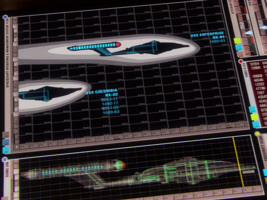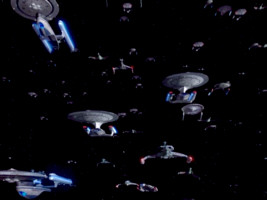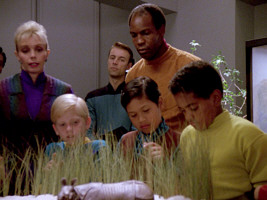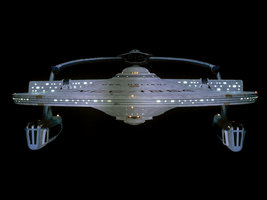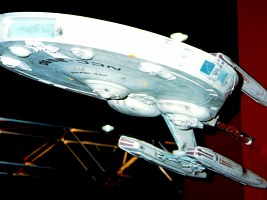Miscellaneous Starship Problems
The meaning of "NCC"
Matt Jefferies is said to have created the famous hull number NCC-1701 of the USS Enterprise by rearranging the registry of his airplane (NC-17740). In any case, "NCC" was never supposed to have any specific meaning apart from being a generic prefix for Starfleet registries. The suggestion that it is an abbreviation for "naval construction contract" is popular in fandom, but is mere speculation. Since other Federation prefixes include "NAR", "NCV", "NFT" or "NSP", it is much more likely that the leading "N" denotes Federation starships. Only "NX" could stand for something specific like "experimental", but there is no real evidence either.
The meaning of "USS"
The letters "USS" are undoubtedly supposed to be reminiscent of "United States Ship". In-universe, the abbreviation was meant to denote "United Space Ship" in the early stages of the Star Trek production. Christopher Pike explicitly stated this in "The Cage". Later on, it was switched to "United Star Ship" which James Kirk mentioned on two occasions in TOS: "The Squire of Gothos" and "Court Martial". There is no problem in accepting both versions, since in the official nomenclature all space ships could have been "promoted" to starships some time after the 2250s.
The ships of 22nd century Earth Starfleet in Star Trek Enterprise don't have name prefixes; at least they are never referred to in spoken or written form. There is only one exception. In ENT: "Divergence" we can see a display, on which the two ships are labeled "USS Enterprise NX-01" and "USS Columbia NX-02". While "USS" may stand for something like "United Sol (System) Ship" here, we are probably allowed to ignore this one-time exception, which almost definitely is a production error.
The meaning of "explorer" or "frigate"
Starfleet ship types are occasionally referred to in Star Trek episodes. For instance, a screen display in "Star Trek III" (actually reproduced from the ship diagrams in the Star Fleet Technical Manual) identifies the Enterprise as a "heavy cruiser". In TNG: "Arsenal of Freedom", the Wambundu class is said to be a "light cruiser". In TNG: "Conspiracy", the Ambassador class is called a "heavy cruiser" and the New Orleans class a "frigate" (although none of them is shown). The Defiant is classified as an "escort" in DS9: "The Search". "Destroyer units", finally, are mentioned by Ben Sisko in DS9: "Sacrifice of Angels". All this points to a classification system quite similar to that of present-day navies, where the designation stands for the ship's size, armament and role in the fleet. The TNGTM, on the other hand, does not mention military designations. According to the book, the ship types denote purposes but also sizes: "The USS Enterprise is categorized as an Explorer, the largest starship in a classification system that includes cruiser, cargo carrier, tanker, surveyor, and scout. While most starships may be adapted for a variety of mission types, the vessel type designations describe their primary purpose."
Whilst there is no problem with all the auxiliary vessels like tankers or cargo ships, which are just what their name says, the question arises what may be the difference between all the "military" designations, also considering that Starfleet is just not supposed to have warships (DS9: "The Search"). The navy classification system may be used only as a matter of tradition. But, in particular, the designation as "explorer" exclusively for the largest type makes little sense, as this is the primary purpose of all capital ships. "Explorer", as a new term probably replacing "battleship", says nothing about the ship's size and doesn't fit into the naval classification system. The entry in the TNGTM is also somewhat contradictory in itself in that it states that the explorer should be the largest ship type, although size wouldn't matter in a classification by primary purposes. The difference between explorer and cruiser is not made clear either.
It has been conjectured that, since the designation as a frigate and the distinction between heavy and light cruiser is missing in the TNGTM, there are actually two parallel type designations: one for the ship's (peace time) role and, optionally, an additional "military" type for the ship's size. According to this theory, the Intrepid class, as a vessel fully equipped with all kinds of weapons and with sensors and labs for long-term exploration, may be an explorer (as the ship's designer Rick Sternbach once suggested), just like the much larger Galaxy class. The Sovereign class, which many fans do not want to accept as a heavy cruiser, although it is a bit smaller in volume than the Ambassador class, may be an explorer likewise. A dual classification system would also allow the term "battleship" to be still in use. In TNG: "Conundrum", the Enterprise, albeit under amnesia, is actually identified as "battleship". But especially "destroyer" and "battleship" would not suit an organization at all that takes pride in the peaceful exploration of space.
Although it may explain everything stated on screen as well as in the reference books, there is no evidence for a dual classification system. Considering the minor role that these designations appear to play in Starfleet, it would be a stretch to assume that there is even a twofold system. It may suffice to agree that the largest fully equipped ship type is called "explorer", although smaller ships are used for exploration too. "Heavy cruiser", "light cruiser", maybe "destroyer" (although the mentioned "destroyer units" do not have to be designations of ship types) and "frigate" are essentially gradually downsized explorers, and there are no battleships or battlecruisers in Starfleet. "Escort" may be an exceptional designation, as Starfleet couldn't fit the Defiant, which has no specific role except for fighting, into their scheme. All support ship types are just called what they are used for.
I suggest to take this question easy. Even in present-day navies the designations may be subject to change, as new frigates are customarily larger than older destroyers, and the latter seem to come out of use anyway. In many cases Starfleet probably doesn't know itself how to categorize a new ship class, just like it was with the Defiant. I wouldn't know how to classify the Prometheus, and please don't ask me about the Saber, Steamrunner or Norway either. There is absolutely no clue. Terms such as "fast attack frigate" or "heavy strike cruiser" should remain in fandom and not make their way into the canon Starfleet.
The size of Starfleet
There are several different approaches to determine the overall number of Starfleet ships. First of all, the registries insinuate that some 76,000 starships have been in service between 2161 and 2376. We can't be positive that the numbers are actually strictly chronological, and we don't know how many ships are or were in service at a time. The mere numbers would allow up to 30,000 ships in the second half of the 24th century. A more careful assumption is that there are rather several thousand than a few hundred starships at a time. The fleet sizes of the Dominion War are more obvious evidence for the size of Starfleet. If there are at least nine fleets with around 200 starships each, we arrive at a few thousand starships.
There is an apparent dilemma, if we compare the high registries and the huge fleets of the Dominion War with what seemed to be a chronic lack of ships in the times of TOS and TNG, where the Enterprise was on its own most of the time. The whole issue, however, has to be assessed completely differently if we further consider the circumstances of the popular setting "We are the only ship in the sector", as it was the case several times in TOS and TNG. A sector is supposedly a cube of 20^3 light years, and traversing a sector is possible with a fast starship in a few days. If the Federation is a sphere of just 200ly diameter, its volume is 4.2 million cubic light years. This is still a lot, in spite of the seemingly small diameter, and it would equal 524 sectors. We would have to take into account that certain sectors in the center of the Federation and at the Cardassian border, for example, would be populated with far more starships than sectors of lower logistic or strategic importance. This makes it very plausible that the Enterprise is sometimes the only starship in a remote sector if there are a few thousand ships altogether. If we like a larger Federation better, the starship density would be even thinner than it was suggested in TNG. The explanation why suddenly large fleets appear during the Dominion War is simple if we take into account that it is only a matter of a few weeks to assemble such a fleet from the ships in neighboring sectors. There was just not enough time in TNG: "The Best of Both Worlds" and "Redemption" where the Federation tried hard to gather 40 and 20 ships, respectively.
Families on Federation starships
We know that it was not customary to have families on Starfleet ships at the time of TOS. At least there were definitely no families on the original USS Enterprise. Families were aboard civilian freighters of the 22nd century, such as the Horizon or the Fortunate in Star Trek Enterprise. It is also possible that research vessels, especially those not belonging to Starfleet, may always have had accommodations for spouses and children of ship officers. But this is only speculation. Some time in the 24th century Starfleet may have admitted families to certain ships. On the Enterprise-D this seems to be a new experience to some of the crew, especially to Picard who is unfamiliar with the presence of children, which he states in TNG: "Encounter at Farpoint". There is no good evidence on families on other Starfleet ships of that time except for the Saratoga as seen in DS9: "Emissary". Ironically this Miranda-class ship is a very old design by the time of its destruction, and we may presume that more recent and/or larger ship classes would be more likely to have families aboard. On the other hand, the Saratoga may just have been an exception, a science vessel that accidentally dropped into the battle, considering that there was even a transport ship with civilians at Wolf 359 as mentioned in VOY: "Infinite Regress".
 There are no families on any ship in recent Star Trek (neither in DIS/SNW nor in Picard), which corroborates the Enterprise-D as the big exception that it was probably always meant to be.
There are no families on any ship in recent Star Trek (neither in DIS/SNW nor in Picard), which corroborates the Enterprise-D as the big exception that it was probably always meant to be.
Hull colors
The hulls of many Starfleet ships, most obviously of Enterprise NX-01, shine as if they were made of bare metal, something like the future equivalent of stainless steel. Some close views of the hull, like in ENT: "Minefield" seem to corroborate this notion. On the other hand, in ENT: "Broken Bow" Archer says to Trip Tucker, "You scratched the paint", after a minor collision of their shuttlepod with the ship's hull. It looks like the pod could have touched the "X" of the ship's registry, which is quite obviously painted on. But it is also possible that the ship is actually coated with a protective paint that includes metallic particles. This would also explain why there is more contrast between the hull panels than surfaces of the same bare metal likely have. As there is no physical model of Enterprise NX-01, anything is possible anyway.
But the hulls of the starships using physical models are just as hard to assess. This is because the miniatures are painted in a way to look good under studio lighting conditions, rather than in normal daylight. The models of the Galaxy class, for instance, are colored in rather odd shades of gray and greenish gray, while they look almost perfectly metallic on screen, especially in the later seasons of TNG and in "Generations". The model of the Enterprise refit was reported to be plain white by visitors of exhibitions, but is actually painted in different shades of gray close to white with different reflectivities. This too is supposed to give us the impression of a metallic surface with the appropriate lighting.
 All Starfleet ships in Discovery and Strange New Worlds have very metallic looking hulls. This applies in particular to the USS Discovery (both before and after the 32nd century refit in DIS: "Die Trying") and to the reimagined USS Enterprise, whose surface structure and color is nothing like that of the ship in TOS.
All Starfleet ships in Discovery and Strange New Worlds have very metallic looking hulls. This applies in particular to the USS Discovery (both before and after the 32nd century refit in DIS: "Die Trying") and to the reimagined USS Enterprise, whose surface structure and color is nothing like that of the ship in TOS.
Ships without deflectors
The navigational deflector is an essential component of every Federation starship, as it is necessary to prevent interstellar particles from hitting the hull. This is explained in the TNGTM and stated by Malcolm Reed in ENT: "Broken Bow". But why are there certain ship classes, like the Miranda or the Constellation, without a deflector dish? A possible explanation lies in the TNGTM where the deflection system is described as consisting of two components: a low-power field to sweep small particles and a focused beam to deflect larger objects such as asteroids. It may be useful to integrate these components into a dish, together with the long-range sensors, but may not be a necessity. I could imagine that an almost unnoticeable forcefield generator may be used to keep small particles away, while a phaser-like emitter or even the phasers themselves may take care of asteroids. So the Miranda and Constellation do have deflectors, we only don't know what they look like exactly and where they are located.
In Star Trek: The Magazine (January 2003), Rick Sternbach suggests that the deflector grid, Bussard collector fields, tractor emitter and asymmetrical warp fields are working together to protect the hull on the Constellation. This sounds very complex compared to a dedicated deflector system, but it is plausible if we look at the possible roles of the single systems. We may assume that the shields and warp field disperse small particles, while the Bussard collector can cut through this field combination to collect stray hydrogen. The tractor beam would be used to deflect larger objects.
As opposed to Federation starships, very few alien ship designs seem to have deflector dishes, even those with similar warp nacelles similar to those of the Federation. This is more evidence that there are other possible configurations of a deflecting system than a dish.
Interstellar travel on a shuttle
The usefulness of shuttles is questionable if their maximum speeds are Warp 4 for the Type-9 shuttle (VOY: "Resolutions") or only Warp 2 for the TNG standard shuttles of Type 6 and Type 7 (according to the Star Trek Fact Files). An interstellar journey would take months or even years with such a sluggish spacecraft. We may also remember a few occasions where even the good old TOS shuttle aka Class F (TOS: "The Menagerie I", "Metamorphosis", "Let That Be Your Last Battlefield") or the Type-15 shuttlepod (TNG: "The Mind's Eye") were used for this purpose - both were most likely meant to have impulse drive only when they were created. The authors obviously haven't given the shuttle issue much thought. Maybe they just assumed that any speed faster than light would do, or that everything with something like a nacelle should be warp-capable. Essentially the same problem exists with the countless alien and civilian freighters creeping through the galaxy at low warp or even sublight speed. I wonder what else aside from fuel and supplies for the crew such a freighter would be able to carry, not to mention the endless boredom on a journey that may take decades.
In some cases it may be argued that a shuttle was dropped by the ship at the edge of a solar system and made only the rest of the travel alone. Nevertheless, it's hard to deny that shuttles are actually used to travel through interstellar space in some other cases. In some specific cases shuttles even managed to catch up or keep pace with starships, like Chakotay did in VOY: "Unity". This is why I think that shuttles are much faster than is usually stated.
 In all of the latest Star Trek series, shuttles are not only warp-capable as a general rule irrespective of the era, they also achieve extremely fast speeds that allows them to travel to nearby star systems in at most a few hours, as seen e.g. in DIS: "If Memory Serves" or "Through the Valley of Shadows".
In all of the latest Star Trek series, shuttles are not only warp-capable as a general rule irrespective of the era, they also achieve extremely fast speeds that allows them to travel to nearby star systems in at most a few hours, as seen e.g. in DIS: "If Memory Serves" or "Through the Valley of Shadows".
Credits
Thanks to Jeff for the hint about the scratched paint on the NX-01 and to Memory Alpha for screen caps.

NC-17740 @ Virginia Aviation Museum

Back to Starship Articles index






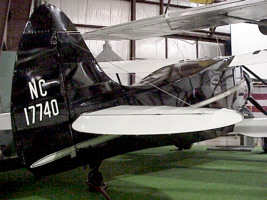
 Matt Jefferies's airplane NC-17740
Matt Jefferies's airplane NC-17740